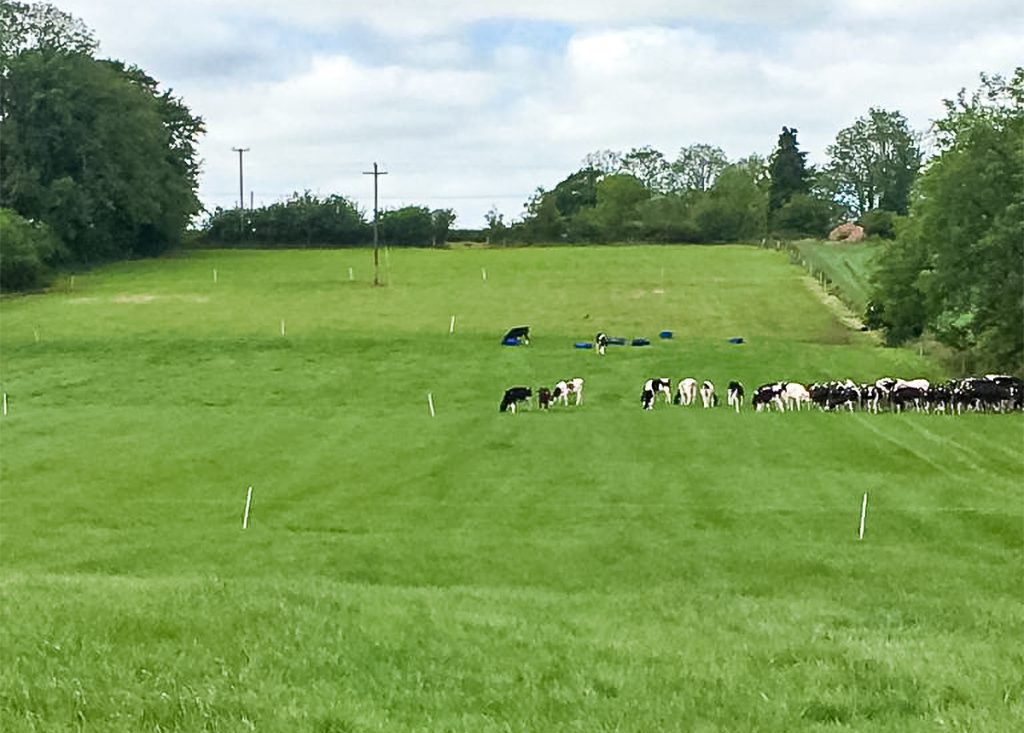By Teagasc’s Seán Cummins and James Fitzgerald
It’s been a challenging spring in terms of grassland management for many of the farmers enrolled in the Teagasc Green Acres Calf to Beef Programme.
Growth is just beginning to surpass demand on many farms, but others – especially those working off high and exposed sites – are struggling to keep grass ahead of stock.
On account of harsh and colder weather conditions, combined with a lack of moisture in some locations, the arrival of magic day is approximately two weeks behind on many of the farms enrolled in the programme.
To balance the shortfall in grass growth, many of the farmers who started grazing early and have lower than desired grass covers for the beginning of the second rotation, had to reintroduce silage back into animals’ diets in a bid to extend the rotation.

Growth Watch – below average
Last week, weather conditions appeared to be turning in favour of grass growth, but below average temperatures – along with a lack of moisture this week – has seen growth remain behind average for the time of year.
Along with a reduction in grazing yields, silage crops are also behind in many locations; an upturn in the weather conditions is badly required to ensure first-cut crops targeted for harvesting in mid to late May bulk up.
Although conditions are challenging at present, there are a number of positives to take. Excellent graze outs are being achieved at farm level and when a burst of growth does come, quality grass will be available for the next rotation.
Elodie Ruelle’s MoSt grass growth model is also pointing to growth rates of 46-71 kg DM/ha/day for farms dotted across the country for the week ahead – sufficient levels of growth to put farmers enrolled in the programme in a position of surplus grass – albeit only a small surplus.
Growth will come, it’s just a matter of making the correct decision at farm level to get you through this tight spot.

In terms of management advice, maintaining the average farm cover is important at this stage, with >550kg DM/ha targeted.
Remember, it takes grass to grow grass and if the farm is floored at this time of the year and cover drops too low, the response when conditions once again become favourable will be reduced.
It’s also important to maintain the rotation length at 20-22 days to allow grass the opportunity to come ahead of stock.
When growth does come in the near future, removing surplus grass in the form of bales will correct any excess grass ahead of stock and allow for pre-grazing yields to be maintained at the targeted levels of 8-10 cm.
Furthermore, it’s critical that the farm is walked regularly as part of a farmer’s growth watch.
Things change very quickly this time of year and by having an up-to-date walk completed will allow the decision to continue or discontinue silage supplementation on farms where it is required to be made with confidence.
[grass_growth_map from=”2021/04/21″ to=”2021/04/28″]
Richard Long, Ballymacarbry, Co. Waterford
- Growth: 16kg DM/ha;
- Demand: 2kg DM/ha;
- Average farm cover: 220kg DM/ha;
- Stocking rate: 0.23 LU/ha.

Growth is badly wanted in the Nire Valley and conditions have been more than difficult over the last number of weeks.
The farm is running about two weeks behind where it normally would be, with grass frosts and cold days not helping the situation.
A growth rate of just 16kg DM/ha/day was recorded over the last week and the farm cover has dropped to 220kg DM/ha.
To avoid farm cover falling excessively low, we had been offering the weanlings half of their demand in the form of grass silage, with the expectation that growth rates would rise above 40kg DM/ha/day.
On account of the weather we’re experiencing, this didn’t occur and now the yearlings have been moved to an all-silage diet.
We had silage in the yard and with ground conditions being exceptional, the decision was made to supplement with silage rather than graze any of the silage ground. Where we are located, we tend to experience long winters, so ensuring there is enough silage in the yard next October, is a high priority.
50 calves have also been turned out to date and they account for the demand being seen on the farm. These animals are being offered 1kg/head/day of concentrate.
Silage crops are still looking poor, with covers hovering around 2,000kg DM/ha. Initially, we’d hoped to have it harvested by mid-May like last year, but with the weather we are after having, this will definitely be pushed back to May 20 unless a serious burst of growth comes over the coming weeks.
We are expecting first-cut silage crops to come in slightly lighter this year, but I don’t want to delay harvesting it any further past May 20, on account of the deterioration in quality.
Michael Culhane, Killaloe, Co. Clare
- Growth: 44kg DM/ha;
- Demand: 44kg DM/ha;
- Average farm cover: 740kg DM/ha;
- Stocking rate: 5.36 LU/ha.

With silage ground closed up and the demand for grass ever building from the grazing stock, April was always likely to be a pinch point.
In the last days of April, I would have thought that grass growth rates would have kicked on well ahead of demand and that the pinch point would be left in the past. This year seems to be different however, with grass growth rates lower than what you’d expect for this time of year.
According to this week’s grass walk results, grass growth and demand on my farm are exactly equal, which is an unusual occurrence.
The average farm cover of 740kg DM/ha is healthy, but needs to be, so as I have a high stocking rate of 5.36Lu/ha on my grazing ground since the silage ground is closed up. The grass cover/Lu is 138kg DM and I would like to build this up to 160-180kg DM as quickly as possible.
In order to ensure that demand doesn’t exceed growth I have started feeding meal to the finishing heifers at grass. They are getting 4.5kg/head in order to help put a better fat score on them quickly and to stretch out the grass that’s in front of them a little better.
A change of plan has also been put in place for the younger heifers, with 6ac of silage ground with the lowest cover of grass being offered to them to delay the start of the next rotation.
All of last year’s silage has been used up, so to slow down their rotation by offering some silage in the field is not an option.
The tight grazing that is going on at the moment is going to stand to us in the long-run as what grows back in its place will be good and leafy, but there are conundrums around keeping grass in front of stock that need to be solved first.
